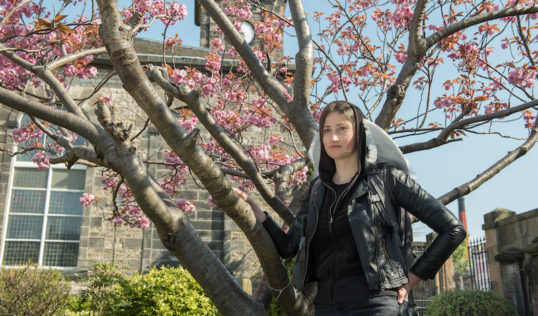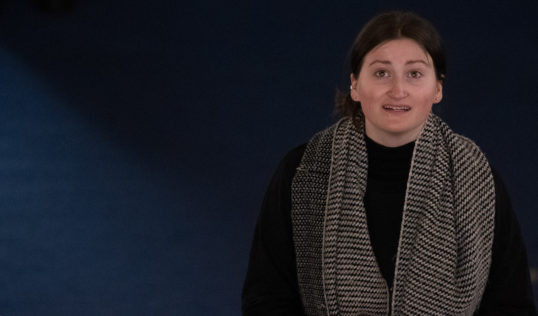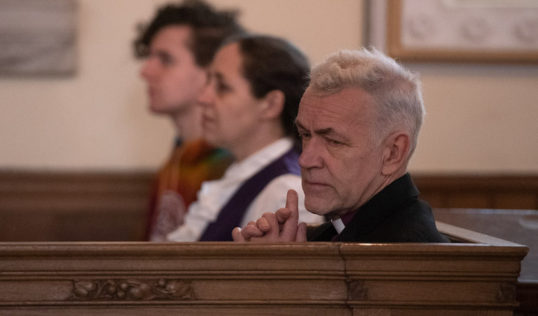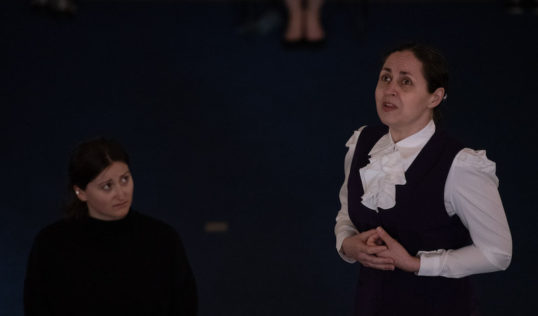Lark rising
EGTG give modern eye to historical story
Edinburgh amateur company EGTG is digging back 600 years to the story of Joan of Arc this week with The Lark, a play that just seems to get more relevant as time goes on.
Using the deconsecrated church at Bellfield in Portobello as its stage, the company is wielding a cast of 23, ranging in ages from 8 to 81, and a playlist including Arcade Fire, Mark Ronson, Hozier and Radiohead, to help bring the story bang up to date.
The Lark, written by Jean Anouilh, is set against the backdrop of the 100 years war which, in 1429, was going badly for France when a 17 year old peasant girl led an army of men into battle and carved a victory that defined France.
She claimed God told her to do it; the church said she was a witch who committed the vile heresy of cross-dressing and should be burnt alive.
Jean Anouilh’s play tells the tale of how Joan convinced the church, the state – and her dad – to let her tackle an apparently impossible feat. And then is witness to her trial: a nineteen year old uneducated woman held to account for her successes by the world’s most educated men.
Anouilh published the script in 1953, having lived through the occupation of France by the German army during the Second World War. His observations about how the French sense of identity was squeezed provide a poignant context to this story.
spirit, vitality and fire
EGTG is staging the Scottish premiere of a new translation by Gill Taylor, first performed by her own theatre group in East London ten years ago, which attempts find the spirit, vitality and fire of Joan in a way that’s meaningful for modern day audiences.
Building on Taylor’s translation, director Claire Wood, musical director Neil Colquhoun and choir mistress Elizabeth McColl are adding a band and a choir into the mix to convey the passion and panache of this fifteenth century revolutionary.
“The word incredible gets bandied around much more than it should but Joan’s story is genuinely incredible,” Claire Wood told Æ. She has been researching the history behind the play and says Joan wasn’t quite the illiterate peasant portrayed in most of the stories.
“She had several siblings, an ordinary mum and dad, a favourite old dog (who also finds his way into the play) and they were all pretty sceptical when, aged 15, she started telling them that she was hearing God talking to her, telling her to save France.
was Joan really hearing God?
‘Though that didn’t stop them enjoying the benefits when Joan did save France! Her parents were rewarded with titles and her entire village was exempted from tax by the King, right up until the French Revolution.
“The question for me then is was Joan really hearing God talking to her?”
Whether she was or not, it is certain Joan ended up in the front of the then Dauphin of France, convinced him to let her lead his Army against the English who she totally trounced in battle and, to universal celebrations, finally saw the Dauphin crowned King of France.
When she was later captured by the English, her trial lasted 80 days, during which she was on her feet for 14 hour days, being interrogated by a pack of over 70 English-supporting clerics, all attempting to catch her out.
“At one level, this is a story about truth and whose version of truth counts for more – a pretty topical question in this era of fake news,” Wood continues. “It’s a tale of a teenage girl taking on the patriarchy. And a tale of the church using its collective wealth and education to crush a girl who was arguably closer to God than any of them.”
“Although Joan lived and died nearly 600 years ago, her story feels incredibly current. A lone teenage girl taking on the world’s leaders to try and make her world a better place? I hope Greta Thunberg’s story has a better ending.
“In the end, Joan’s patriarchy could find so little to pin on her that they prosecuted her for wearing trousers. As the debate continues to rage about how women should and shouldn’t behave, this script asks a bunch of questions about how far we should go for the things we believe in.”
sonic benefits
Music will be an important part of the EGTG’s staging – and in such a way as to make the use of both the music available – Maneater by Nelly Furtado and Behind The Armory by case/lang/veirs were among the rejected possibilities – and the sonic benefits of the venue itself.
MD Neil Colquhoun told Æ: “We wanted to use songs which both fit the feel of the play at the relevant times in terms of lyrical content and mood, but also where possible which obliquely (or less obliquely) referenced Joan herself.
“While we have made use of the choir in the performances, the songs have been arranged for a band to play. The intention is that the space will allow for the choir, who will be dispersed around the stage and environs, plus the instrumentation to achieve more of an expansive sound than would be possible in a more traditional theatre venue.”
What ever the outcome, it seems that EGTG continues to plough a furrow of big concept productions, delivered with style and a great deal of attention to the details.
The Lark
Bellfield, 16B Bellfield Street, Portobello, EH15 2BP
Tuesday 4 – Saturday 8 June 2019.
Evenings: 7.30pm.
Buses: 26 and 45 stop nearby on Portobello High Street.
Tickets and details: Book here.
ENDS

























Comments (1)
Trackback URL | Comments RSS Feed
Sites That Link to this Post